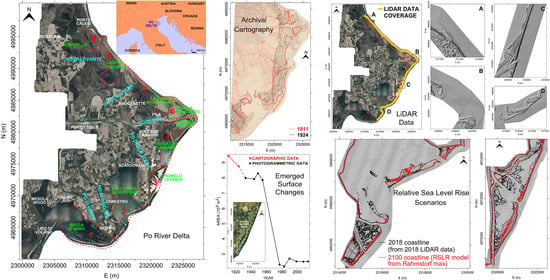Monitoring the Coastal Changes of the Po River Delta (Northern Italy) since 1911 Using Archival Cartography, Multi-Temporal Aerial Photogrammetry and LiDAR Data: Implications for Coastline Changes in 2100 A.D.
Abstract
1. Introduction
2. Study Area and Instability Process
3. Materials and Methods
3.1. Available Datasets
3.1.1. Archival Cartographies
3.1.2. Aerial Photogrammetric Surveys
3.1.3. LiDAR Data
3.2. Methods for the Coastline Changes Evaluation
3.2.1. Aerial Photogrammetric Images Orientation and Coastline Restitution
3.2.2. Co-Registration between Archival Cartographic and Photogrammetric Data
3.2.3. Emerged Surfaces Computation from LiDAR Data
3.2.4. Scenario of Emerged Surfaces by 2100
4. Results
4.1. Data Processing and 3-D Models Extraction
4.2. Co-Registration Accuracy
4.3. Coastline Restitutions and Changes Detection
4.4. Sub-Aerial Surface Changes
4.5. Prevision of Emerged Surfaces in 2100
5. Discussion
6. Conclusions
Funding
Acknowledgments
Conflicts of Interest
References
- Ericson, J.P.; Vörösmarty, C.J.; Dingman, S.L.; Ward, L.G.; Meybeck, M. Effective sea-level rise and deltas: Causes of change and human dimension implications. Glob. Planet. Chang. 2006, 50, 63–82. [Google Scholar] [CrossRef]
- Brooks, B.A.; University of Hawaii; Bawden, G.; Manjunath, D.; Werner, C.; Knowles, N.; Foster, J.H.; Dudas, J.; Cayan, D.; Survey, U.G.; et al. Contemporaneous Subsidence and Levee Overtopping Potential, Sacramento-San Joaquin Delta, California. San Francisco Estuary Watershed Sci. 2012, 10, 10. [Google Scholar] [CrossRef]
- Wolstencroft, M.; Shen, Z.; Törnqvist, T.E.; Milne, G.A.; Kulp, M. Understanding subsidence in the Mississippi Delta region due to sediment, ice, and ocean loading: Insights from geophysical modeling. J. Geophys. Res. Solid Earth 2014, 119, 3838–3856. [Google Scholar] [CrossRef]
- Minderhoud, P.S.J.; Erkens, G.; Pham, V.H.; Bui, V.T.; Erban, L.; Kooi, H.; Stouthamer, E. Impacts of 25 years of groundwater extraction on subsidence in the Mekong delta, Vietnam. Environ. Res. Lett. 2017, 12, 064006. [Google Scholar] [CrossRef] [PubMed]
- Saleh, M.; Becker, M. New estimation of Nile Delta subsidence rates from InSAR and GPS analysis. Environ. Earth Sci. 2018, 78, 6. [Google Scholar] [CrossRef]
- Syvitski, J.P.M.; Kettner, A.J.; Overeem, I.; Hutton, E.W.H.; Hannon, M.T.; Brakenridge, G.R.; Day, J.W.; Vorosmarty, C.J.; Saito, Y.; Giosan, L.; et al. Sinking deltas due to human activities. Nat. Geosci. 2009, 2, 681–686. [Google Scholar] [CrossRef]
- National Research Council. Mitigating Losses from Land Subsidence in the United States; The National Academies Press: Washington, DC, USA, 1991; p. 58. [Google Scholar] [CrossRef]
- Yerro, A.; Corominas, J.; Monells, D.; Mallorquí, J.J. Analysis of the evolution of ground movements in a low densely urban area by means of DInSAR technique. Eng. Geol. 2014, 170, 52–65. [Google Scholar] [CrossRef]
- Costantini, M.; Ferretti, A.; Minati, F.; Falco, S.; Trillo, F.; Colombo, D.; Novali, F.; Malvarosa, F.; Mammone, C.; Vecchioli, F.; et al. Analysis of surface deformations over the whole Italian territory by interferometric processing of ERS, Envisat and COSMO-SkyMed radar data. Remote. Sens. Environ. 2017, 202, 250–275. [Google Scholar] [CrossRef]
- Hung, W.-C.; Hwang, C.; Chen, Y.-A.; Zhang, L.; Chen, K.-H.; Wei, S.-H.; Huang, D.-R.; Lin, S.-H. Land Subsidence in Chiayi, Taiwan, from Compaction Well, Leveling and ALOS/PALSAR: Aquaculture-Induced Relative Sea Level Rise. Remote. Sens. 2017, 10, 40. [Google Scholar] [CrossRef]
- Baldi, P.; Fabris, M.; Marsella, M.; Monticelli, R. Monitoring the morphological evolution of the Sciara del Fuoco during the 2002–2003 Stromboli eruption using multi-temporal photogrammetry. ISPRS J. Photogramm. Remote. Sens. 2005, 59, 199–211. [Google Scholar] [CrossRef]
- Baldi, P.; Cenni, N.; Fabris, M.; Zanutta, A. Kinematics of a landslide derived from archival photogrammetry and GPS data. Geomorphology 2008, 102, 435–444. [Google Scholar] [CrossRef]
- Fabris, M.; Baldi, P.; Anzidei, M.; Pesci, A.; Bortoluzzi, G.; Aliani, S. High resolution topographic model of Panarea Island by fusion of photogrammetric, lidar and bathymetric digital terrain models. Photogramm. Rec. 2010, 25, 382–401. [Google Scholar] [CrossRef]
- Mancini, F.; Dubbini, M.; Gattelli, M.; Stecchi, F.; Fabbri, S.; Gabbianelli, G. Using Unmanned Aerial Vehicles (UAV) for High-Resolution Reconstruction of Topography: The Structure from Motion Approach on Coastal Environments. Remote. Sens. 2013, 5, 6880–6898. [Google Scholar] [CrossRef]
- Huang, C.; Zhang, H.; Zhao, J. High-Efficiency Determination of Coastline by Combination of Tidal Level and Coastal Zone DEM from UAV Tilt Photogrammetry. Remote. Sens. 2020, 12, 2189. [Google Scholar] [CrossRef]
- Pesci, A.; Fabris, M.; Conforti, D.; Loddo, F.; Baldi, P.; Anzidei, M. Integration of ground-based laser scanner and aerial digital photogrammetry for topographic modelling of Vesuvio volcano. J. Volcanol. Geotherm. Res. 2007, 162, 123–138. [Google Scholar] [CrossRef]
- Pesci, A.; Teza, G.; Casula, G.; Fabris, M.; Bonforte, A. Remote Sensing and Geodetic Measurements for Volcanic Slope Monitoring: Surface Variations Measured at Northern Flank of La Fossa Cone (Vulcano Island, Italy). Remote. Sens. 2013, 5, 2238–2256. [Google Scholar] [CrossRef]
- Jaud, M.; Bertin, S.; Beauverger, M.; Augereau, E.; Delacourt, C. RTK GNSS-Assisted Terrestrial SfM Photogrammetry without GCP: Application to Coastal Morphodynamics Monitoring. Remote. Sens. 2020, 12, 1889. [Google Scholar] [CrossRef]
- Fiaschi, S.; Fabris, M.; Floris, M.; Achilli, V. Estimation of land subsidence in deltaic areas through differential SAR interferometry: The Po River Delta case study (Northeast Italy). Int. J. Remote Sens. 2018, 39, 8724–8745. [Google Scholar] [CrossRef]
- Anzidei, M.; Bosman, A.; Carluccio, R.; Casalbore, D.; Caracciolo, F.D.; Esposito, A.; Nicolosi, I.; Pietrantonio, G.; Vecchio, A.; Carmisciano, C.; et al. Flooding scenarios due to land subsidence and sea-level rise: A case study for Lipari Island (Italy). Terra Nova 2017, 29, 44–51. [Google Scholar] [CrossRef]
- Antonioli, F.; Anzidei, M.; Amorosi, A.; Presti, V.L.; Mastronuzzi, G.; Deiana, G.; De Falco, G.; Fontana, A.; Fontolan, G.; Lisco, S.; et al. Sea-level rise and potential drowning of the Italian coastal plains: Flooding risk scenarios for 2100. Quat. Sci. Rev. 2017, 158, 29–43. [Google Scholar] [CrossRef]
- Zambon, M. Abbassamento del Suolo per Estrazioni di Acqua e Gas: Deduzioni ed Indirizzi Logicamente Conseguenti per la Sistemazione del Delta del Fiume Po. In Proceedings of the 23nd National Conference on “Bonifiche”, Rome, Italy, 20 May 1967; pp. 345–370. [Google Scholar]
- Caputo, M.; Pieri, L.; Unguendoli, M. Geometric investigation of the subsidence in the Po Delta. Boll. Geofis. Teor. Appl. 1970, 47, 187–207. [Google Scholar]
- Caputo, M.; Folloni, G.; Gubellini, A.; Pieri, L.; Unguendoli, M. Survey and geometric analysis of the phenomena of subsidence in the region of Venice and its hinterland. Riv. Ital. Geofis. 1972, 21, 19–26. [Google Scholar]
- Bock, Y.; Wdowinski, S.; Ferretti, A.; Novali, F.; Fumagalli, A. Recent subsidence of the Venice Lagoon from continuous GPS and interferometric synthetic aperture radar. Geochem. Geophys. Geosystems 2012, 13, 03023. [Google Scholar] [CrossRef]
- Tosi, L.; Da Lio, C.; Strozzi, T.; Teatini, P. Combining L- and X-Band SAR Interferometry to Assess Ground Displacements in Heterogeneous Coastal Environments: The Po River Delta and Venice Lagoon, Italy. Remote. Sens. 2016, 8, 308. [Google Scholar] [CrossRef]
- Simeoni, U.; Corbau, C. A review of the Delta Po evolution (Italy) related to climatic changes and human impacts. Geomorphology 2009, 107, 64–71. [Google Scholar] [CrossRef]
- Carminati, E.; Martinelli, G. Subsidence rates in the Po Plain, northern Italy: The relative impact of natural and anthropogenic causation. Eng. Geol. 2002, 66, 241–255. [Google Scholar] [CrossRef]
- Carminati, E.; Martinelli, G.; Severi, P. Influence of glacial cycles and tectonics on natural subsidence in the Po Plain (Northern Italy): Insights from14C ages. Geochem. Geophys. Geosystems 2003, 4, 1–14. [Google Scholar] [CrossRef]
- Colombo, C.; Tosini, L. Sessant’anni di Bonifica Nel Delta del Po, 1st ed.; Papergraf S.p.a. Publisher: Padova, Italy, 2009; pp. 3–217. ISBN 978-88-87264-70-8. [Google Scholar]
- Borgia, G.; Brighenti, G.; Vitali, D. La Coltivazione dei Pozzi Metaniferi del Bacino Polesano e Ferrarese. Esame Critico della Vicenda. Ina Georisorse Territ. 1982, 425, 13–23. [Google Scholar]
- Bitelli, G.; Bonsignore, F.; Unguendoli, M. Levelling and GPS networks to monitor ground subsidence in the Southern Po Valley. J. Geodyn. 2000, 30, 355–369. [Google Scholar] [CrossRef]
- Baldi, P.; Casula, G.; Cenni, N.; Loddo, F.; Pesci, A. GPS-based monitoring of land subsidence in the Po Plain (Northern Italy). Earth Planet. Sci. Lett. 2009, 288, 204–212. [Google Scholar] [CrossRef]
- Tosi, L.; Teatini, P.; Strozzi, T.; Carbognin, L.; Brancolini, G.; Rizzetto, F. Ground surface dynamics in the northern Adriatic coastland over the last two decades. RENDICONTI Lince- 2010, 21, 115–129. [Google Scholar] [CrossRef]
- Cenni, N.; Viti, M.; Baldi, P.; Mantovani, E.; Bacchetti, M.; Vannucchi, A. Present vertical movements in Central and Northern Italy from GPS data: Possible role of natural and anthropogenic causes. J. Geodyn. 2013, 71, 74–85. [Google Scholar] [CrossRef]
- Gornitz, V. Sea-level rise: A review of recent past and near-future trends. Earth Surf. Process. Landforms 1995, 20, 7–20. [Google Scholar] [CrossRef]
- Carbognin, L.; Tosi, L. Interaction between Climate Changes, Eustacy and Land Subsidence in the North Adriatic Region, Italy. Mar. Ecol. 2002, 23, 38–50. [Google Scholar] [CrossRef]
- Carbognin, L.; Teatini, P.; Tosi, L. Eustacy and land subsidence in the Venice Lagoon at the beginning of the new millennium. J. Mar. Syst. 2004, 51, 345–353. [Google Scholar] [CrossRef]
- Carbognin, L.; Teatini, P.; Tomasin, A.; Tosi, L. Global change and relative sea level rise at Venice: What impact in term of flooding. Clim. Dyn. 2009, 35, 1039–1047. [Google Scholar] [CrossRef]
- Carbognin, L.; Teatini, P.; Tosi, L.; Strozzi, T.; Tomasin, A. Present relative sea level rise in the northern Adriatic coastal area. In Coastal and Marine Spatial Planning. Marine Research at CNR-Theme 3; Brugnoli, E., Cavarretta, G., Mazzola, S., Trincardi, F., Ravaioli, M., Santoleri, R., Eds.; CNR-DTA Publisher: Rome, Italy, 2011; pp. 1123–1138. [Google Scholar]
- Vilibić, I.; Šepić, J.; Pasarić, M.; Orlić, M. The Adriatic Sea: A Long-Standing Laboratory for Sea Level Studies. Pure Appl. Geophys. PAGEOPH 2017, 174, 3765–3811. [Google Scholar] [CrossRef]
- Antonioli, F.; De Falco, G.; Presti, V.L.; Moretti, L.; Scardino, G.; Anzidei, M.; Bonaldo, D.; Carniel, S.; Leoni, G.; Furlani, S.; et al. Relative Sea-Level Rise and Potential Submersion Risk for 2100 on 16 Coastal Plains of the Mediterranean Sea. Water 2020, 12, 2173. [Google Scholar] [CrossRef]
- Elias, P.; Benekos, G.; Perrou, T.; Parcharidis, I. Spatio-Temporal Assessment of Land Deformation as a Factor Contributing to Relative Sea Level Rise in Coastal Urban and Natural Protected Areas Using Multi-Source Earth Observation Data. Remote. Sens. 2020, 12, 2296. [Google Scholar] [CrossRef]
- Fabris, M. Coastline evolution of the Po River Delta (Italy) by archival multi-temporal digital photogrammetry. Geomat. Nat. Hazards Risk 2019, 10, 1007–1027. [Google Scholar] [CrossRef]
- Baldi, P.; Coltelli, M.; Fabris, M.; Marsella, M.; Tommasi, P. High precision photogrammetry for monitoring the evolution of the NW flank of Stromboli volcano during and after the 2002–2003 eruption. Bull. Volcanol. 2007, 70, 703–715. [Google Scholar] [CrossRef]
- Marsella, M.A.; Baldi, P.; Coltelli, M.; Fabris, M. The morphological evolution of the Sciara del Fuoco since 1868: Reconstructing the effusive activity at Stromboli volcano. Bull. Volcanol. 2011, 74, 231–248. [Google Scholar] [CrossRef]
- Vecchio, A.; Anzidei, M.; Serpelloni, E.; Florindo, F. Natural Variability and Vertical Land Motion Contributions in the Mediterranean Sea-Level Records over the Last Two Centuries and Projections for 2100. Water 2019, 11, 1480. [Google Scholar] [CrossRef]
- Anzidei, M.; Doumaz, F.; Vecchio, A.; Serpelloni, E.; Pizzimenti, L.; Civico, R.; Greco, M.; Martino, G.; Enei, F. Sea Level Rise Scenario for 2100 A.D. in the Heritage Site of Pyrgi (Santa Severa, Italy). J. Mar. Sci. Eng. 2020, 8, 64. [Google Scholar] [CrossRef]
- Scardino, G.; Sabatier, F.; Scicchitano, G.; Piscitelli, A.; Milella, M.; Vecchio, A.; Anzidei, M.; Mastronuzzi, G. Sea-Level Rise and Shoreline Changes Along an Open Sandy Coast: Case Study of Gulf of Taranto, Italy. Water 2020, 12, 1414. [Google Scholar] [CrossRef]
- Lambeck, K.; Antonioli, F.; Anzidei, M.; Ferranti, L.; Leoni, G.; Scicchitano, G.; Silenzi, S. Sea level change along the Italian coast during the Holocene and projections for the future. Quat. Int. 2011, 232, 250–257. [Google Scholar] [CrossRef]
- Rahmstorf, S. A Semi-Empirical Approach to Projecting Future Sea-Level Rise. Sci. 2007, 315, 368–370. [Google Scholar] [CrossRef]
- IPCC. Climate Change 2013: The Physical Science Basis. In Contribution of Working Group I to the Fifth Assessment Report of the Intergovernmental Panel on Climate Change; Stocker, T.F., Qin, D., Plattner, G.-K., Tignor, M., Allen, S.K., Boschung, J., Nauels, A., Xia, Y., Bex, V., Midgley, P.M., Eds.; Cambridge University Press: Cambridge, UK; New York, NY, USA, 2013; p. 1535. [Google Scholar]
- Fabris, M.; Pesci, A. Automated DEM extraction in digital aerial photogrammetry: Precisions and validation for mass movement monitoring. Ann. Geophys. 2005, 48, 57–72. [Google Scholar] [CrossRef]
- Bosman, A.; Romagnoli, C.; Madricardo, F.; Correggiari, A.; Remia, A.; Zubalich, R.; Fogarin, S.; Kruss, A.; Trincardi, F. Short-term evolution of Po della Pila delta lobe from time lapse high-resolution multibeam bathymetry (2013–2016). Estuar. Coast. Shelf Sci. 2020, 233, 106533. [Google Scholar] [CrossRef]
- Consorzio di Bonifica Delta del Po. Le Lagune del Delta del Po; Consorzio di Bonifica del Delta del Po: Rovigo, Italy, 2013; pp. 4–83.
- Özer, I.E.; Rikkert, S.J.H.; Van Leijen, F.J.; Jonkman, S.N.; Hanssen, R.F. Sub-seasonal Levee Deformation Observed Using Satellite Radar Interferometry to Enhance Flood Protection. Sci. Rep. 2019, 9, 2646. [Google Scholar] [CrossRef]
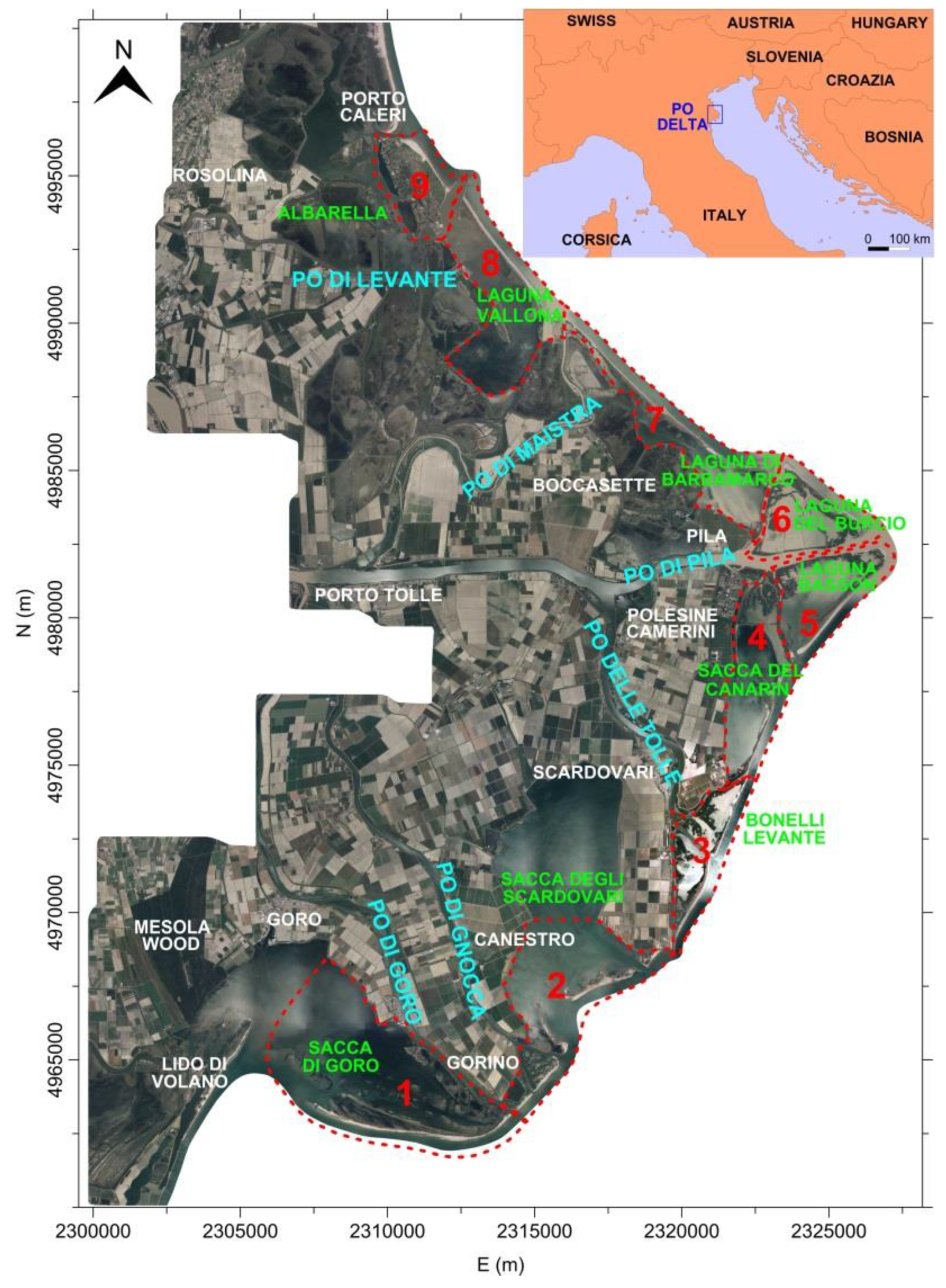
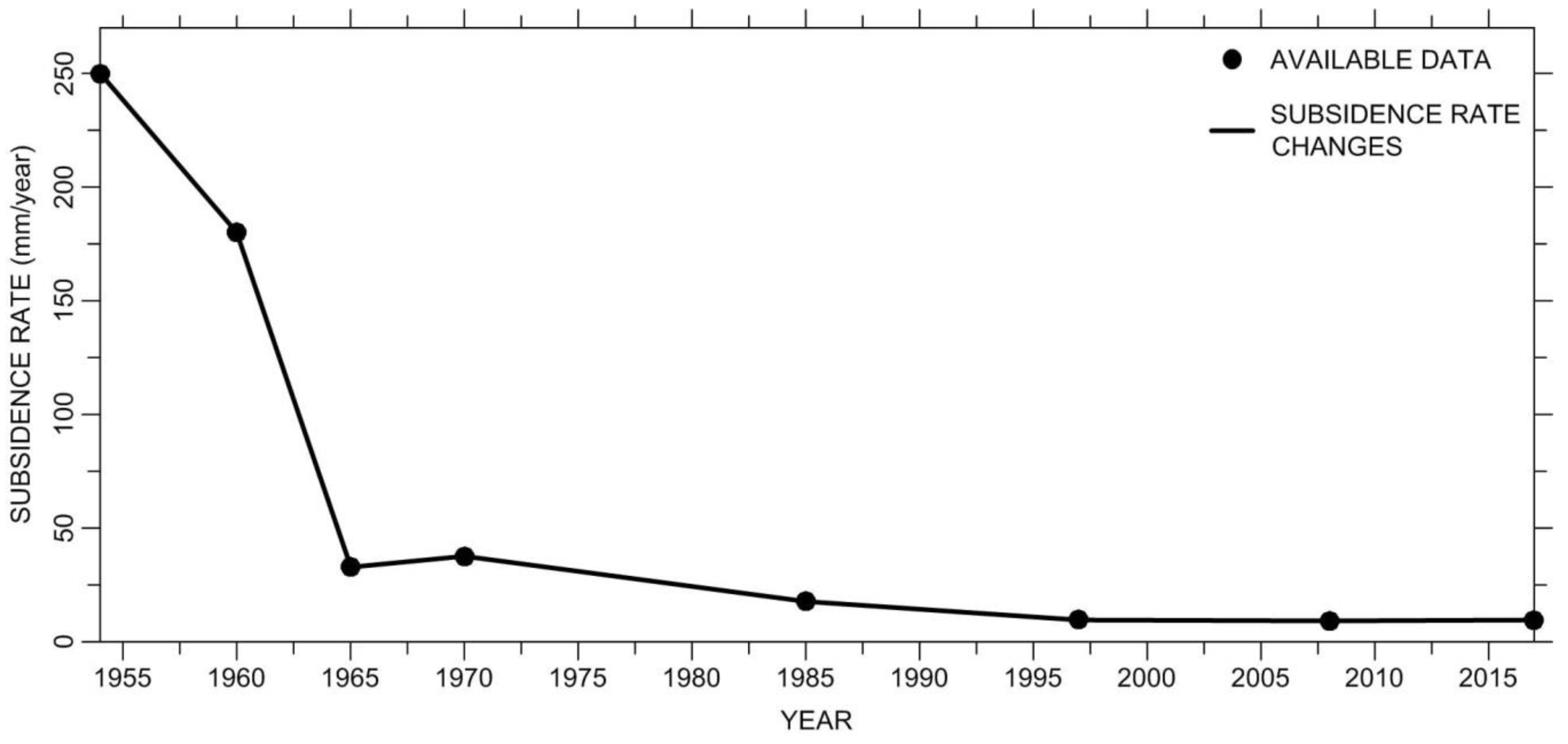
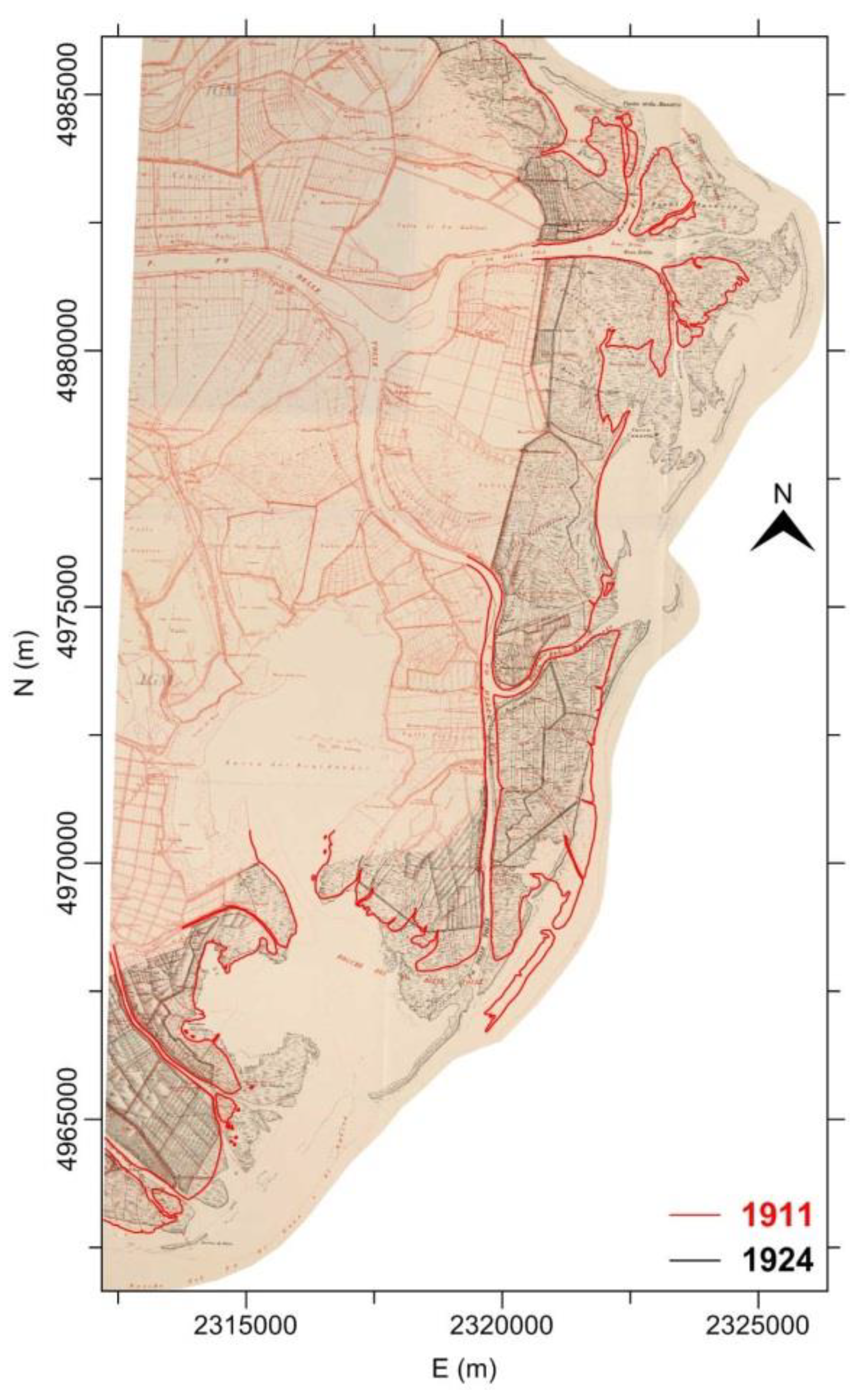
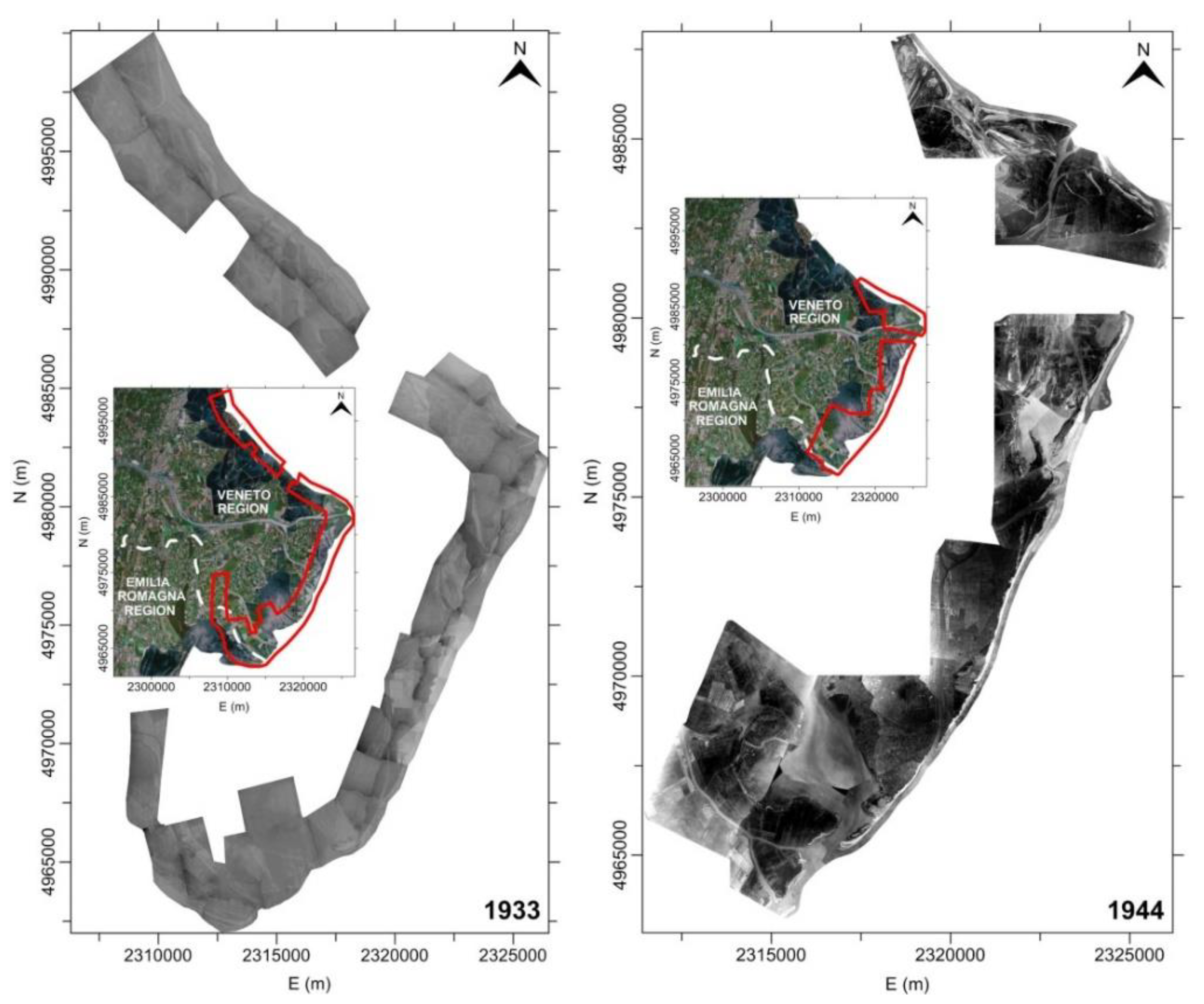
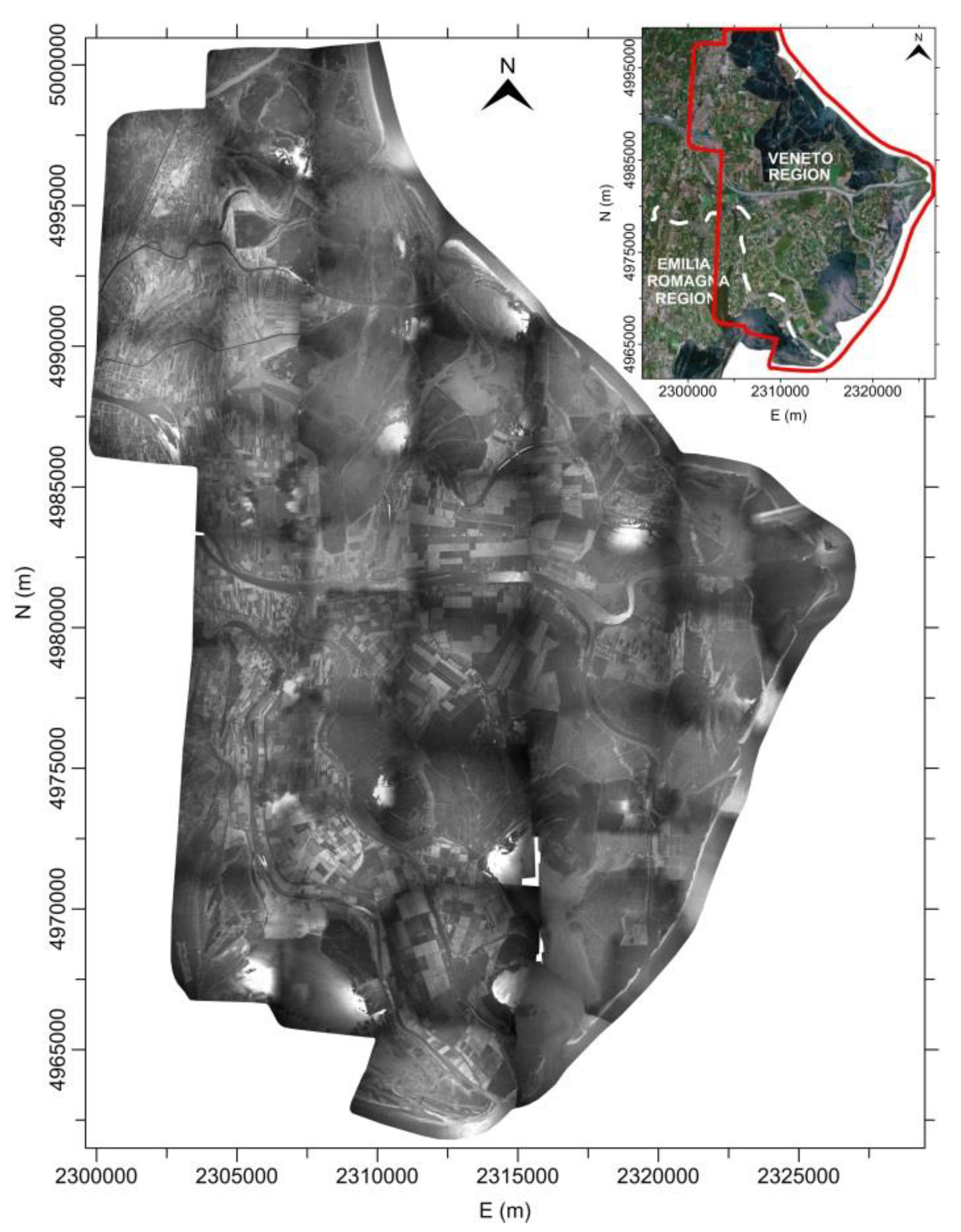
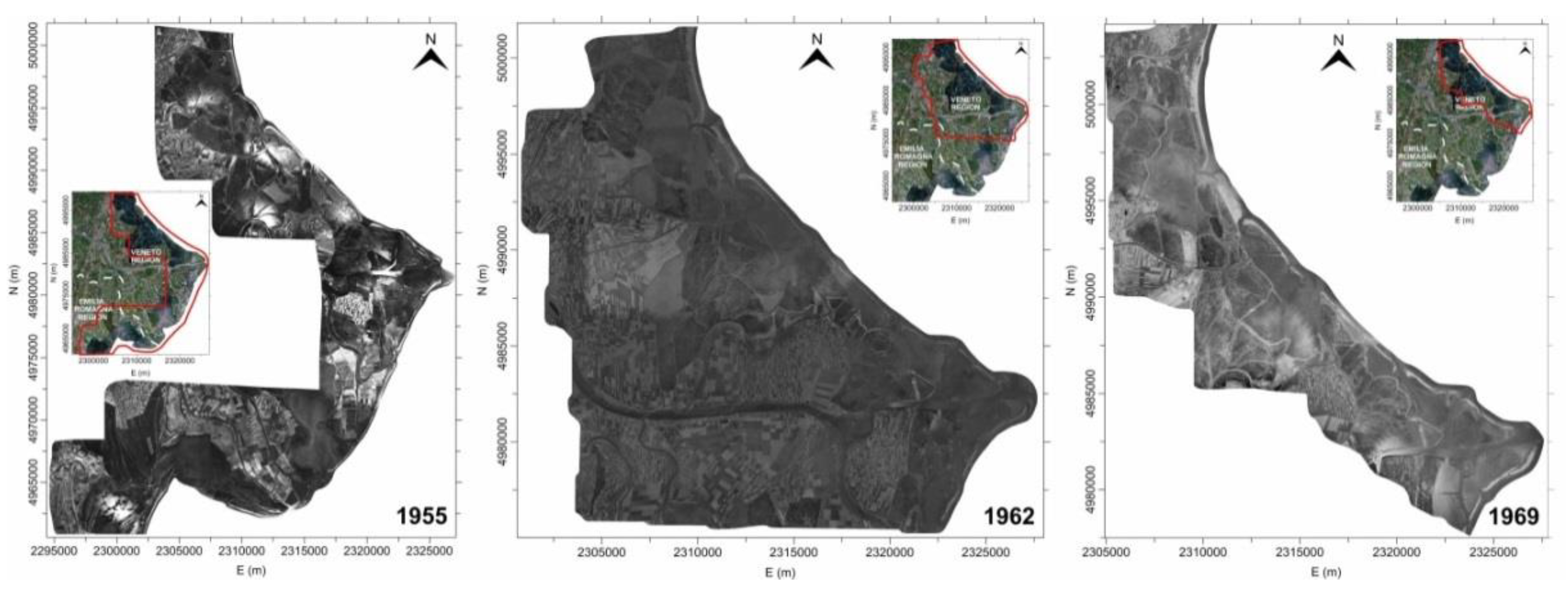
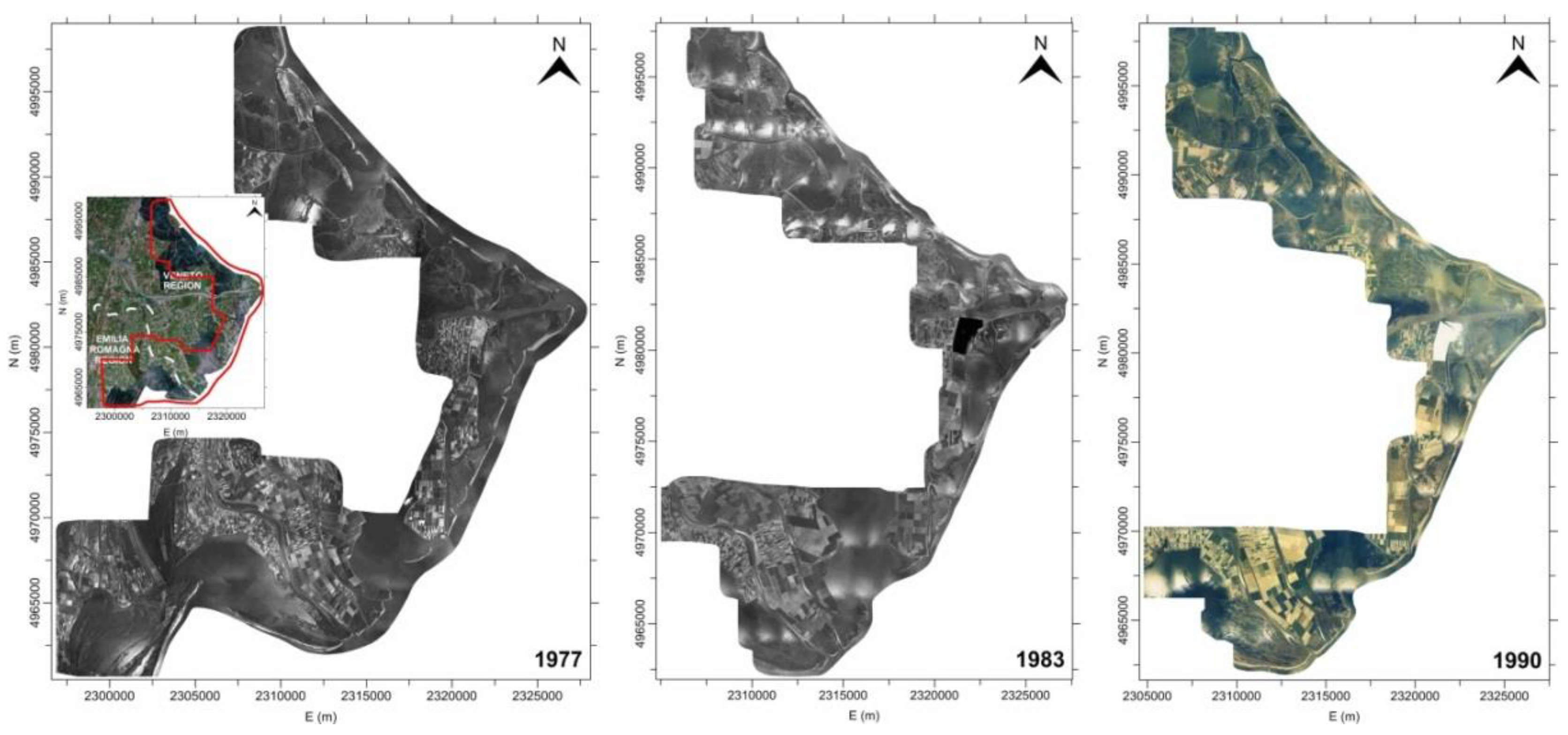
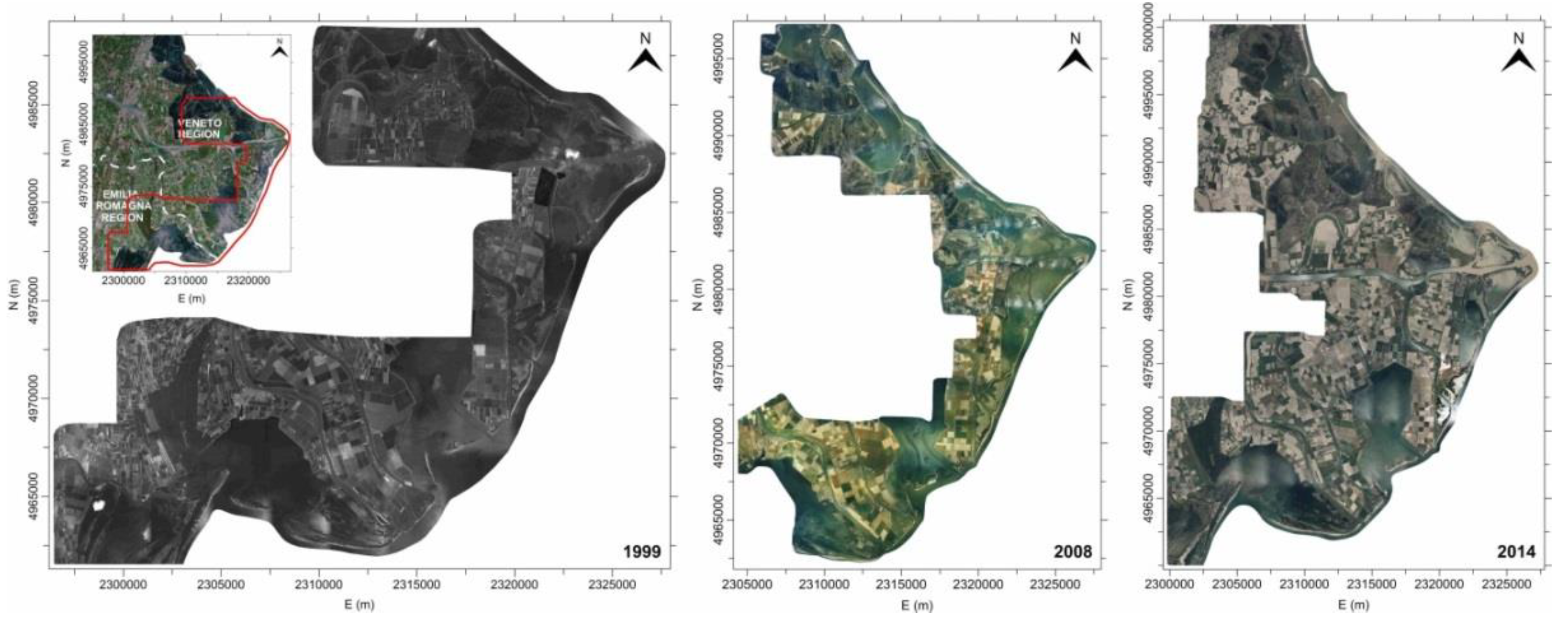
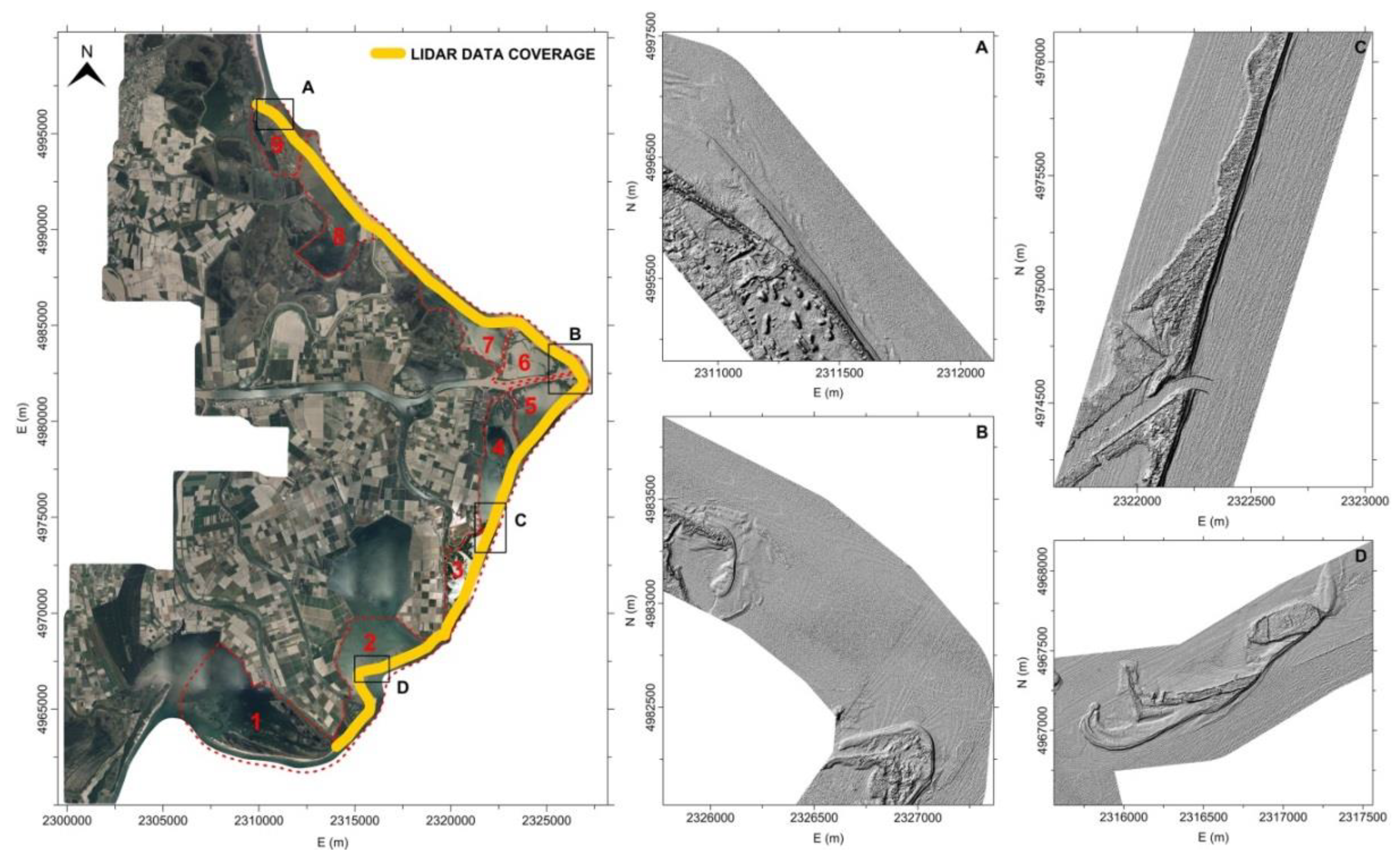

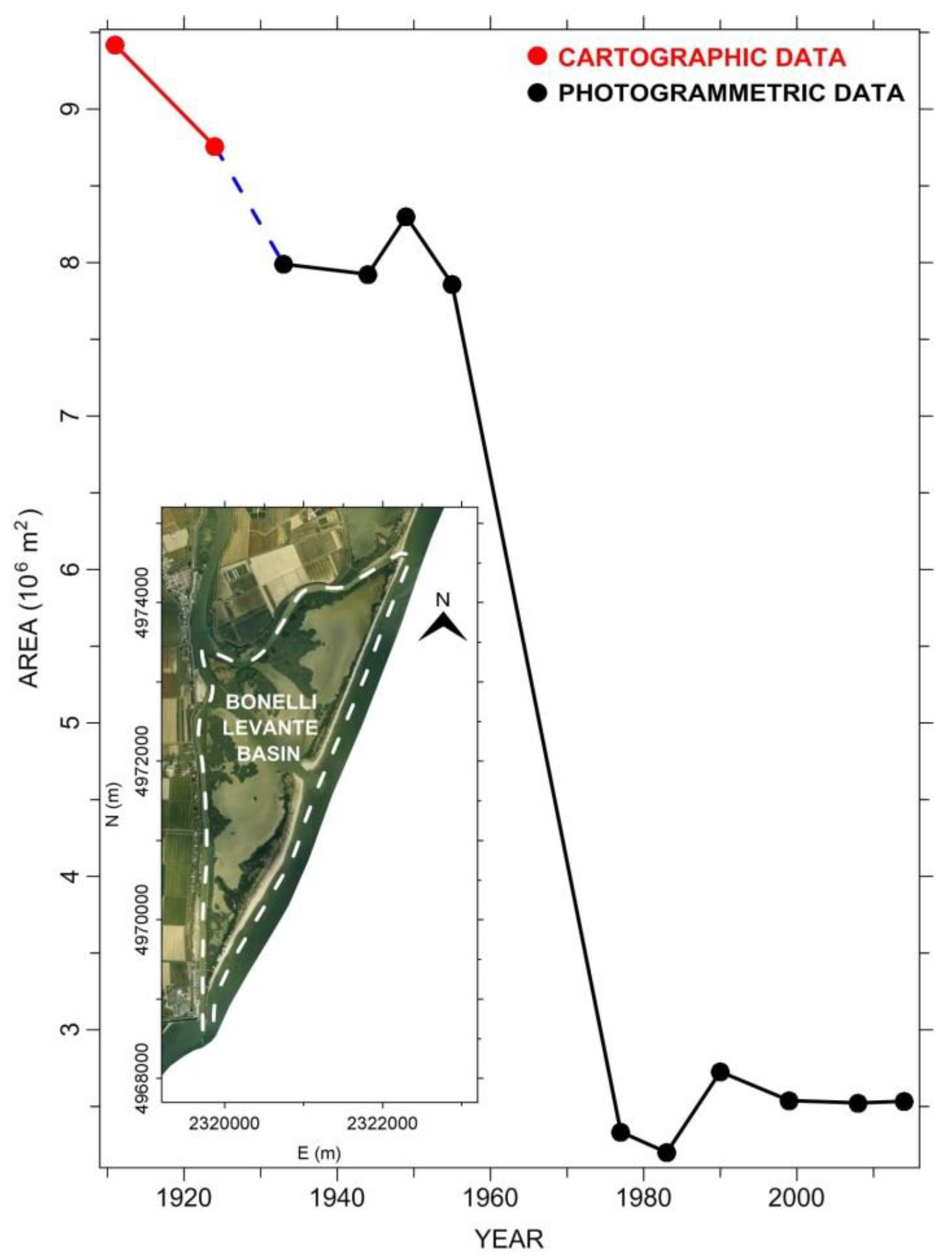

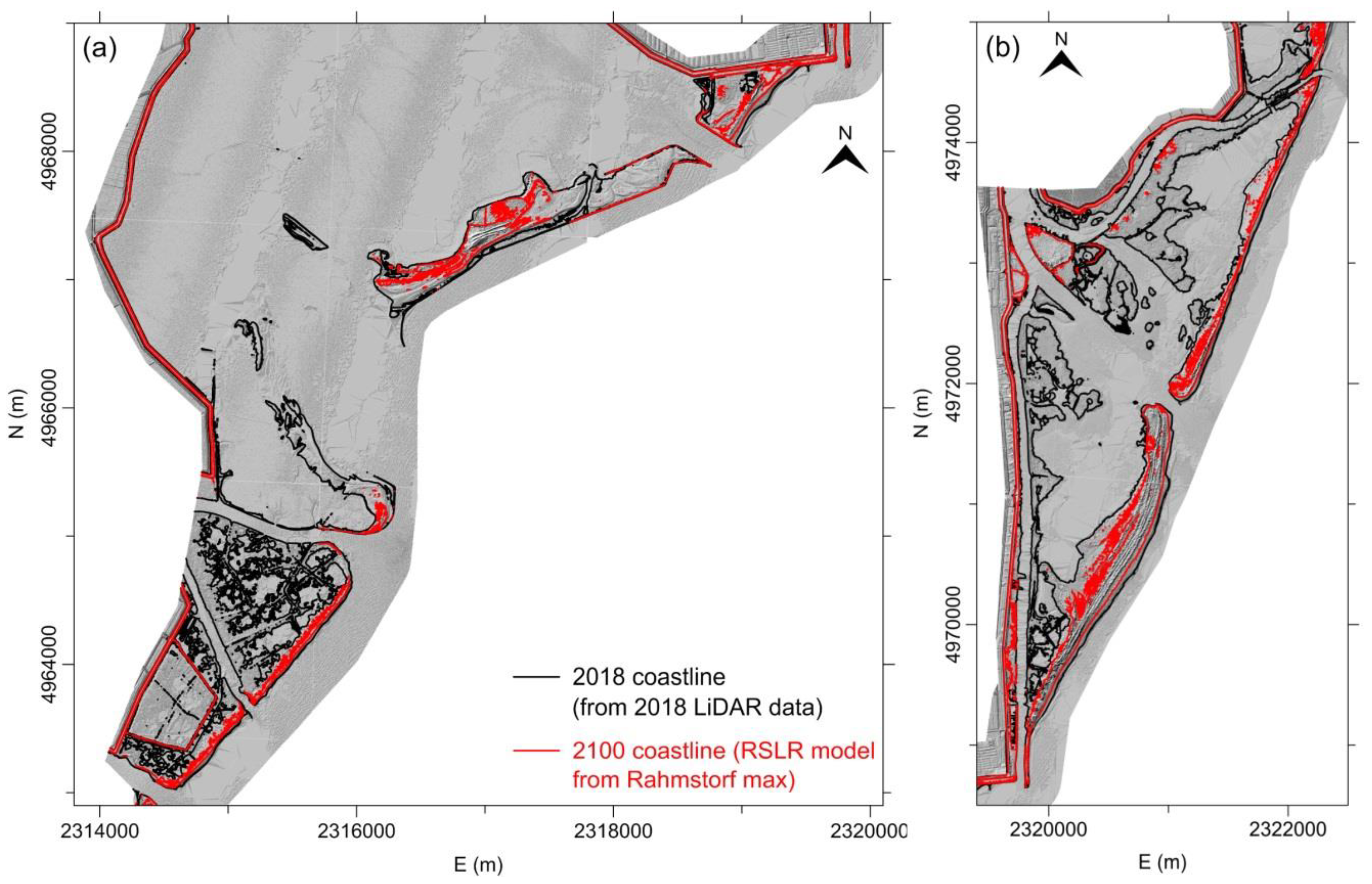
| Year | Date | N. Strips | N. Images | Scale | Photo Size (cm) | Calibrated Focal Length (mm) | Visibility on Images | Scans (dpi) | GSD (cm) |
|---|---|---|---|---|---|---|---|---|---|
| 1933 | - | 6 | 106 | - | 13 × 18 | - | very poor | 1200 | 30 |
| 1944 | - | 8 | 57 | 1:25,000 | 24 × 24, 18 × 24 | 24, 20 inch 1 | poor | 1200 | 55 |
| 1949 | 10–19 July | 9 | 60 | 1:18,000 | 30 × 30 | 200.500 1 | poor | 1200 | 40 |
| 1955 | 1 June–22 July | 8 | 33 | 1:35,000 | 23 × 23 | 154.170 1 | poor | 1000 | 80 |
| 1962 | 8–11 July | 8 | 49 | 1:31,000 | 23 × 23 | 153.030 | poor | 1000 | 80 |
| 1969 | 16–17 July | 6 | 25 | 1:29,000 | 23 × 23 | 152.720 | poor | 1000 | 70 |
| 1977 | 10 October | 8 | 32 | 1:30,000 | 23 × 23 | 152.620 | good | 1000 | 70 |
| 1983 | 10 May–5 June | 13 | 78 | 1:17,000 | 23 × 23 | 153.330 | good | 800 | 50 |
| 1990 | 5–30 May | 13 | 70 | 1:20,000 | 23 × 23 | 151.770 | good | 800 | 60 |
| 1999 | 10 September | 5 | 24 | 1:34,000 | 23 × 23 | 152.900 | good | 1000 | 80 |
| 2008 | 21–22 August | 14 | 125 | 1:16,000 | 23 × 23 | 153.875 | good | 800 | 50 |
| 2014 | 6–24 May | 8 | 72 | 1:78,000 | 11310 × 17310 pi × el | 100.500 | good | 4233 | 50 |
| Year | Date | Sensor | Tide (m) | Resolution (Points/m2) | Average Covered Area (km × km) |
|---|---|---|---|---|---|
| 2006 | 26 April | Optech ALTM 3033 | −0.37 | 1.84 | 0.75 × 57 |
| 2009 | 7 March | Optech ALTM Gemini | −0.32 | 1.84 | 0.75 × 57 |
| 2012 | 17 September | Optech ALTM Gemini | −0.30 | 2.03 | 1 × 57 |
| 2018 | 14 April | Optech ALTM Galaxy | −0.35 | 2.38 | 1–5 × 57 |
| Comparison | Measured Points | Average (m) | St. Dev. (m) | |
|---|---|---|---|---|
| 1924–1949 | 18 | E | 1.19 | 3.27 |
| N | −1.25 | 2.94 | ||
| 1933–1944 | 21 | E | 0.68 | 1.86 |
| N | −0.58 | 1.75 | ||
| 1944–1949 | 38 | E | −0.23 | 1.41 |
| N | −0.58 | 1.33 | ||
| 1949–1955 | 54 | E | 0.53 | 1.21 |
| N | 0.32 | 1.13 | ||
| 1955–1962 | 66 | E | −0.34 | 0.84 |
| N | 0.42 | 0.75 | ||
| 1962–1969 | 66 | E | −0.31 | 0.78 |
| N | 0.27 | 0.73 | ||
| 1969–1977 | 66 | E | 0.21 | 0.76 |
| N | −0.08 | 0.84 | ||
| 1977–1983 | 88 | E | 0.28 | 0.77 |
| N | 0.19 | 0.65 | ||
| 1983–1990 | 86 | E | −0.25 | 0.67 |
| N | 0.29 | 0.71 | ||
| 1990–1999 | 84 | E | 0.19 | 0.63 |
| N | −0.22 | 0.68 | ||
| 1999–2008 | 84 | E | −0.33 | 0.59 |
| N | 0.27 | 0.57 | ||
| 2008–2014 | 100 | E | 0.14 | 0.55 |
| N | −0.09 | 0.49 |
| Comparison | Measured Points | Average (m) | St Dev. (m) | |
|---|---|---|---|---|
| 2006–2009 | 33 | E | −0.08 | 0.22 |
| N | 0.11 | 0.20 | ||
| V | 0.07 | 0.24 | ||
| 2009–2012 | 31 | E | 0.05 | 0.18 |
| N | −0.01 | 0.18 | ||
| V | 0.09 | 0.19 | ||
| 2012–2014 | 28 | E | −0.13 | 0.53 |
| N | 0.10 | 0.57 | ||
| V | −0.09 | 0.48 | ||
| 2014–2018 | 42 | E | 0.15 | 0.55 |
| N | 0.11 | 0.49 | ||
| V | 0.12 | 0.56 | ||
| 2012–2018 | 31 | E | −0.06 | 0.20 |
| N | −0.04 | 0.16 | ||
| V | 0.05 | 0.18 |
| Comparison | Average (m) | Standard Deviation (m) |
|---|---|---|
| 2006–2009 | 0.03 | 0.22 |
| 2009–2012 | 0.06 | 0.15 |
| 2012–2018 | 0.03 | 0.16 |
| Comparisons/Area | 2 | 3 | 4 | 5 | 6 | 7 | 8 | 9 |
|---|---|---|---|---|---|---|---|---|
| 2006–2009 (106 m2) | −0.12 | −0.02 | 0.01 | −0.08 | −0.03 | 0.00 | 0.06 | 0.01 |
| 2009–2012 (106 m2) | 0.42 | 0.28 | 0.17 | 0.16 | 0.27 | 0.29 | 0.28 | 0.06 |
| 2012–2018 (106 m2) | 0.03 | 0.03 | −0.03 | 0.09 | −0.03 | 0.35 | 0.21 | −0.04 |
| Model/Area | Year | 2 | 3 | 4 | 5 | 6 | 7 | 8 | 9 |
|---|---|---|---|---|---|---|---|---|---|
| LiDAR DTM (106 m2) | 2018 | 3.60 | 2.94 | 1.27 | 1.49 | 1.43 | 2.49 | 2.01 | 4.23 |
| IPCC 8.5 min (106 m2) | 2100 | 1.89 | 1.85 | 0.85 | 1.21 | 0.87 | 1.50 | 1.34 | 4.21 |
| IPCC 8.5 max (106 m2) | 2100 | 1.02 | 0.92 | 0.61 | 1.02 | 0.59 | 1.09 | 1.19 | 4.12 |
| Rahmstorf max (106 m2) | 2100 | 0.38 | 0.68 | 0.38 | 0.52 | 0.30 | 0.70 | 0.83 | 4.00 |
Publisher’s Note: MDPI stays neutral with regard to jurisdictional claims in published maps and institutional affiliations. |
© 2021 by the author. Licensee MDPI, Basel, Switzerland. This article is an open access article distributed under the terms and conditions of the Creative Commons Attribution (CC BY) license (http://creativecommons.org/licenses/by/4.0/).
Share and Cite
Fabris, M. Monitoring the Coastal Changes of the Po River Delta (Northern Italy) since 1911 Using Archival Cartography, Multi-Temporal Aerial Photogrammetry and LiDAR Data: Implications for Coastline Changes in 2100 A.D. Remote Sens. 2021, 13, 529. https://doi.org/10.3390/rs13030529
Fabris M. Monitoring the Coastal Changes of the Po River Delta (Northern Italy) since 1911 Using Archival Cartography, Multi-Temporal Aerial Photogrammetry and LiDAR Data: Implications for Coastline Changes in 2100 A.D. Remote Sensing. 2021; 13(3):529. https://doi.org/10.3390/rs13030529
Chicago/Turabian StyleFabris, Massimo. 2021. "Monitoring the Coastal Changes of the Po River Delta (Northern Italy) since 1911 Using Archival Cartography, Multi-Temporal Aerial Photogrammetry and LiDAR Data: Implications for Coastline Changes in 2100 A.D." Remote Sensing 13, no. 3: 529. https://doi.org/10.3390/rs13030529
APA StyleFabris, M. (2021). Monitoring the Coastal Changes of the Po River Delta (Northern Italy) since 1911 Using Archival Cartography, Multi-Temporal Aerial Photogrammetry and LiDAR Data: Implications for Coastline Changes in 2100 A.D. Remote Sensing, 13(3), 529. https://doi.org/10.3390/rs13030529





